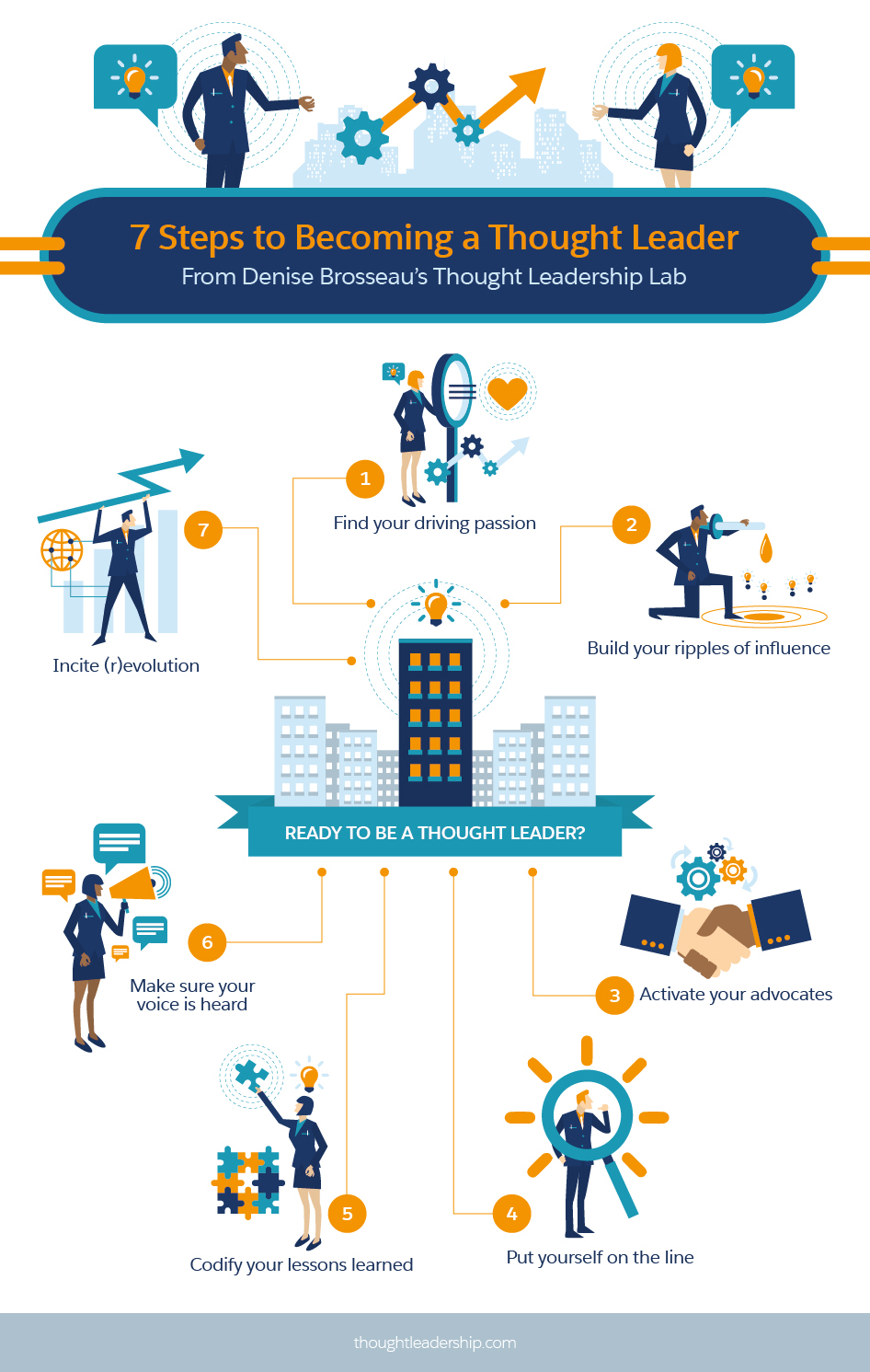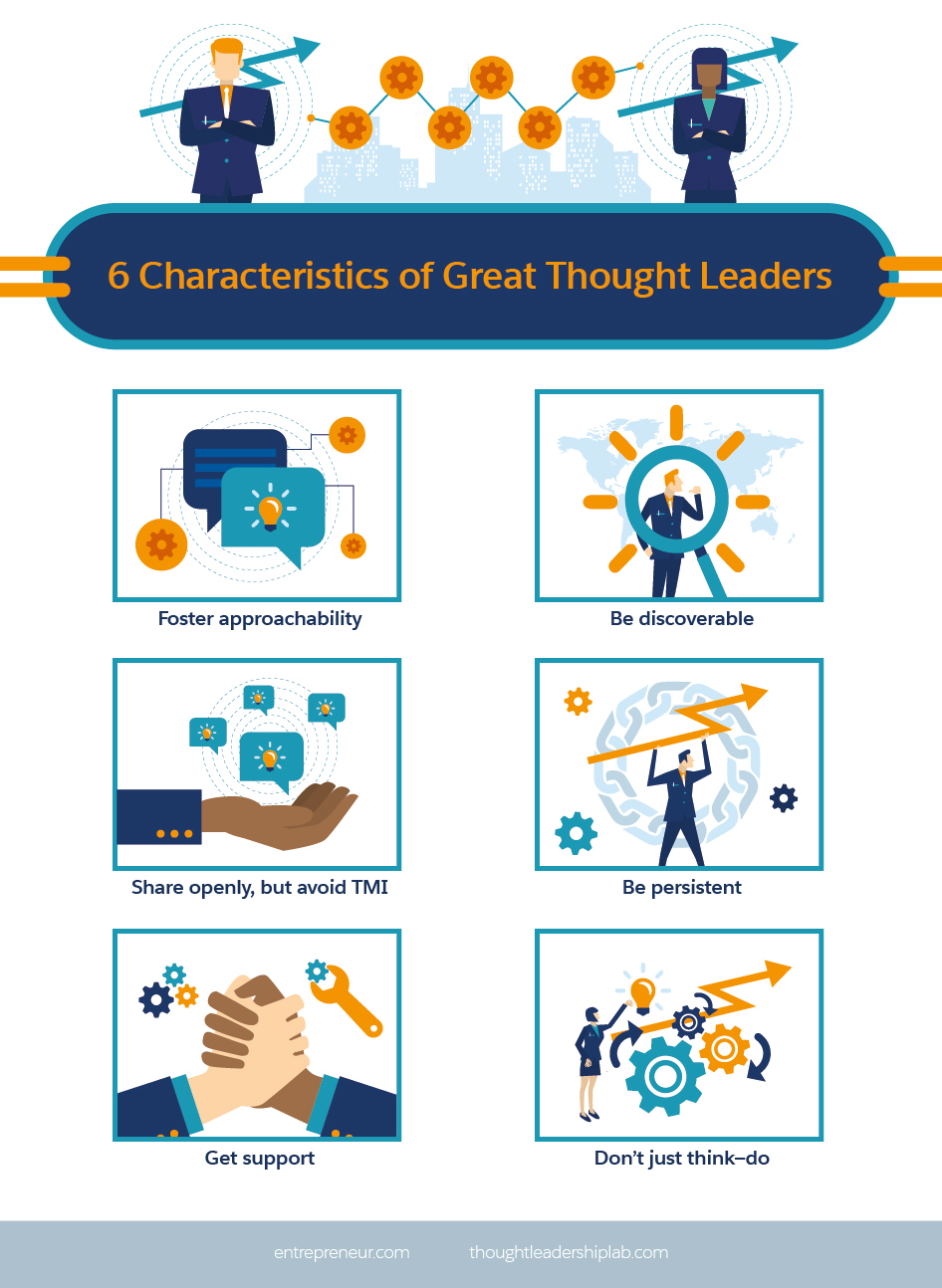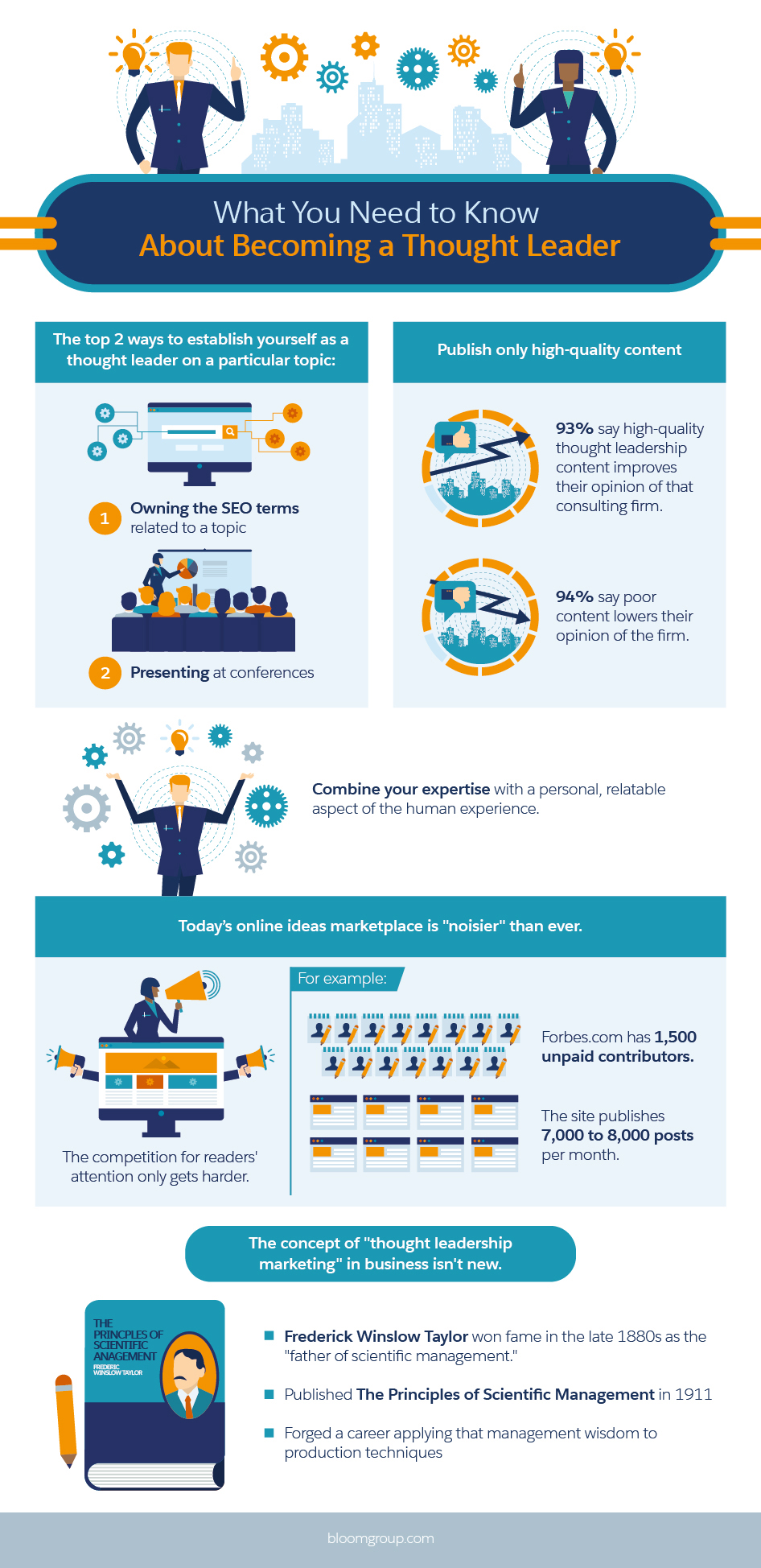9 “Simple” Steps to Become a Thought Leader in Your Industry



It takes determination and patience to become a thought leader, but you can do it. Here's how.

Jessica Bennett
Being a thought leader in your industry is a pretty nice gig if you can manage it. Consider it the adult equivalent of being the high school quarterback or captain of the cheerleading squad. Everyone wants to be your friend, they hang onto your every word, and your opinions practically become the law of the land. There’s just one small problem: You can’t snag this esteemed title quickly or easily.
Building yourself up as a respected and legit thought leader takes incredible focus and commitment, unwavering effort, and smart strategizing. It won’t be easy, but the reward of establishing yourself as an industry thought leader is far more satisfying (and lucrative) than any short-term achievement.
Why Do You Want to Be a Thought Leader?
Maybe you’ve never understood the draw of the limelight; even so, that doesn’t mean you should shy away from it as an adult, especially if you want to make a difference in your industry. Writing on the subject for Forbes, Shel Israel defines a thought leader as “someone who looks at the future and sets a course for it that others will follow . . . They foment change, often causing great disruption.”
If you like the idea of reshaping the conversation of your industry, then you already have the mindset of a thought leader. Here are just a few more reasons to lace up and start walking down the thought leader path:
- Career elevation: Those who never speak up don’t get remembered, and they certainly don’t get promoted. Dorie Clark, author of Reinventing You, explains, “Good employees and good executives are nice to have. Thought leaders are irreplaceable—and indispensable.”
- Company elevation: Thought leaders often become synonymous with their companies. As the reputation of the thought leader rises, so follows their company brand. Steve Jobs’s well-known obsession with perfection built him a legion of Apple fans who were and are willing to pay for just about anything his company makes.
- Open doors: The more you put your name and ideas out into the world, the more opportunities will come your way. Rachael Ray took the simple concept of easy-to-make 30-minute meals and turned it into a lifestyle empire.
- Real change: The most powerful reason to position yourself as a thought leader is that you can bring about real change in your industry. The business world hangs on the words of people like Richard Branson, Warren Buffet, Elon Musk, and Sheryl Sandberg. They don’t just influence the global conversation—they grab the wheel and steer.
The journey to thought leadership land can be long and challenging. If you’re not sure how to get started, here’s a nifty map with nine steps that can put you on the right path to becoming a respected voice in your industry.
7 Steps to Becoming a Thought Leader
From Denise Brosseau’s Thought Leadership Lab

Step One: Carve Out Your Personal Brand
Thought leaders, by their very nature, stand out from the crowd. They have strong and compelling personalities that appeal to their respective audiences. Rachael Ray has perfected her folksy everyday woman brand that fits with the no-fuss meals that she promoted on 30 Minute Meals, the Food Network show that launched her to fame.
Your personal brand should be a natural extension of who you already are. That said, you may want to emphasize certain aspects of your personality. Above all: Be authentic.
You also need to define your niche:
- What are your opinions about your industry?
- How are they different or unique from the voices that already dominate the field?
- Can you stand out even more in your niche? (You can always broaden your focus as you gain more attention.)
Don’t forget to give plenty of thought to who your audience is. Who are your people, and what ideas will capture their attention and loyalty? All of this information is essential before you even start.
Step Two: Start Spreading Your Viewpoints
Standing on a soapbox on your front lawn might amuse your neighbors, but it isn’t going to help you build a following. As a thought leader, your most powerful tool will be a platform from which to begin spreading your ideas. For many thought leaders, this is a personal blog. For example, Wil Wheaton’s blog cemented his reputation as a leading voice for all things nerd and geek. He amplifies his reach with his wildly popular Twitter feed.
If the thought of churning out an endless stream of blogs has you breaking into a cold sweat, rest assured that a blog isn’t your only option. Plenty of thought leaders spread their gospel through podcasts and videos. Gary Vaynerchuk made his name as a social media guru in part by creating the binge-worthy #AskGaryVee show on YouTube.
Pro tip: If you can’t commit to the rigors of regular blogging, vlogging, podcasting, or whatever the next hip thing to do is, start small by spreading your ideas on your social media channel. Elon Musk gets by without a blog or podcast, but his Twitter feed has over 4.8 million followers. Likewise, Vala Afshar, with over 140,000 Twitter followers, is also a regular contributor to The Huffington Post.
Step Three: Build Your Platform into a Destination
As a thought leader-in-training, you need to put a lot of sweat equity into turning your platform into a destination. One blog a month isn’t going to cut it. Neither will a sprinkling of Instagram pictures. Instead, you need to produce a lot of content on a consistent basis that is as good as you can make it. In an article for Entrepreneur, Jayson Demers encourages readers to “start making bolder claims in your articles, and making bigger predictions about the future of your industry.”
Most likely, you won’t get a lot of attention right away. That’s normal. Keep writing, recording, and posting. One of the reasons Richard Branson has over 8 million followers on Twitter is because the founder of Virgin Group has posted over 13,000 tweets! Want to match his influence? Start racking up quality tweets, blogs, and more content.
6 Characteristics of Great Thought Leaders
- Foster approachability
- Be discoverable
- Share openly, but avoid TMI
- Be persistent
- Get support
- Don’t just think—do

Step Four: Expand Your Spotlight
Eventually you’ll want to see what’s going on outside of your own little fishbowl. The world is vast, and your audience is scattered. It’s up to you to expand your spotlight so they can find you. The easiest way to do this is to develop social media channels that allow you to share your daily thoughts and observations, and engage in the current conversation of the day. Social media can also let you showcase your latest blog post, YouTube video, or podcast episode.
Of course, you can only do so much on your own platforms. Now is the time to find new audiences. Figure out what blogs, podcasts, magazines, email newsletters, and YouTube channels your audience loves and then start pitching guest posts, interviews, and other collaborations. Craft compelling, personalized pitches. You’ll probably receive a whole bunch of dead air back, but it only takes a few yeses for you to dramatically grow your visibility.
Pro tip: Who says everyone has to do you favor? Invite other up-and-coming thought leaders to guest blog on your platform, co-host a podcast, or sit down for a video interview.
Step Five: Network, Network, Network
Your industry is likely already home to a wide range of thought leaders. These individuals have already built up their audiences, and have star power they may be able to bestow upon you. Effective networking could lead to collaborations and even partnerships that launch you into the big leagues. Rachael Ray was doing great at building her brand, but appearing in multiple guest segments on the Oprah Winfrey Show and the Dr. Phil Show catapulted her into celebrity status.
Of course, if you don’t have Oprah’s number in your Rolodex, there are other ways to start networking. Carolyn Edgecomb of iMPACT Branding & Design suggests writing blogs or creating pieces around your favourite thought leaders or their companies to catch their attention. Promote the post on your social media pages, making sure to tag the thought leader. You may be surprised by how many of them will share or retweet your mention.
Another good tactic is to share and comment on the blogs, social media posts, videos, and other content of the industry leaders you admire. Additionally, if you can, attend industry conferences and events that bring thought leaders together. A lot of small touches can help raise awareness of your name among the heavy hitters in your field.
Google Search History for “Thought Leadership”

Step Six: Hit the Speaking Tour
It’s hard to imagine that Tony Robbins—one of the world’s most popular self-help gurus—gave his inspiring presentations to small groups when he was first getting started. These days, he can easily fill thousand-seat auditoriums. Perhaps you will, too, but, like Tony Robbins, you’ll need to start small as you build your brand.
Speaking not only puts you directly in front of new audiences, it also forces you to polish your special focus, lends you authority in your field, and gives you the opportunity to network on equal footing with your fellow speakers, panelists, and keynotes. Author Dorie Clark explains, “Given the terror that public speaking instills in most people, your street cred will automatically skyrocket when you take the stage.”
Don’t wait around for the folks at TED to call you. Instead, actively pitch yourself as a speaker, panelist, or workshop leader. Clark suggests reaching out to your local Rotary Club and Chamber of Commerce to get started. With a few successful speeches under your belt, you can pitch regional conferences, major industry events, and in-house speeches to big corporations.
Pro tip: Even if you think you’re too small time for a specific event, pitch anyway. You never know if an event is struggling to fill all of its speaking slots or if organizers are dealing with a speaker who dropped out at the last minute.
Step Seven: Get Published
If you keep your eyes on the prize, you’ll slowly but surely start building a name for yourself. Now is not the time to slow down. Instead, it’s the perfect moment to use all of the thought leadership mojo you’ve built—as well as the unique perspective you’ve polished across hundreds of blog posts and speeches—to create something outstanding. For many thought leaders, this is a book that shares their philosophy and insights with the world. We all know how Sheryl Sandberg’s Lean In turned her into one of the biggest authorities on empowering professional women.
Crafting a book (or creating premium content in some other form) is a great way of creating a new revenue stream that leverages your growing reputation. It also gives you something that you can sell after your speeches. However, the greatest benefit of having a book or a product that contains premium knowledge is the authority that it can lend to your brand. Clark puts it best: “There is no more definitive proof of thought leadership than authoring a good book on your chosen subject.”
What You Need to Know About Becoming a Thought Leader
- The top 2 ways to establish yourself as a thought leader on a particular topic:
- #1: Owning the SEO terms related to a topic
- #2: Presenting at conferences
- Publish only high-quality content
- 93% say high-quality thought leadership content improves their opinion of that consulting firm
- 94% say poor content lowers their opinion of the firm
- Combine your expertise with a personal aspect of the human experience people can relate to
- Today’s online ideas marketplace is “noisier” than ever
- The competition for readers’ attention only gets harder
- For example:
- Forbes.com has 1,500 unpaid contributors
- The site publishes 7,000 to 8,000 posts per month
- The concept of “thought leadership marketing” in business isn’t new

Step Eight: Keep It Going
If you work hard enough and smart enough, and find a message that truly resonates with your audience, then you will reach a tipping point where things become much easier. You won’t be sending out dozens of guest blog pitches only to hear crickets in return. People will ask you for interviews. Conferences will ask you speak. Your social media audience will seem to grow on its own. In other words, you’ve made it, or at least a good deal of people have started to listen to you.
At this point it’s easy to sit back and let the waves of adoration keep on coming, but the job of a thought leader never stops. Now that more people are listening, you need to be as sharp as ever, or you could become yesterday’s news. Don’t slack off and regurgitate the same ideas on your blog. Keep reaching for new ideas and ways to push your industry forward.
Now is also the time that you can make a play to break through. Rachael Ray wasn’t just satisfied with one show. Today, she is a lifestyle brand, complete with cookbooks, a line of cookware, her own magazine, three shows on the Food Network, and a syndicated daytime show called Rachael Ray. She certainly didn’t rest on her laurels, and neither should you!
Step Nine: Pay It Forward
Yeah, you’re kind of a big deal now, but you didn’t get there on your own. Along the way, someone gave you the chance to guest blog on their bustling platform. Someone else took a chance and let you speak at a conference even though you only had a few small speaking credits to your name. Your idol may have even re-tweeted a link to one of your podcasts, giving you that big bump in listeners.
Now it’s your turn. There are others on the trail behind you taking the long, arduous hike to become thought leaders. When you can, give them a helping hand. This isn’t charity: The unknown professional you help today could become tomorrow’s thought leader superstar, ready and willing to collaborate with you on the next great thing.
The Road Is Long, but the Journey Is Worth the Effort
If you want to be a thought leader in your industry, you need to work at it every single day. The road is long, and it may be lonely for months (or even years) as you work to define your personal brand and build your unique platform. However, if you can find a powerful and unique message, and articulate it in a way that resonates with your audience, the sky is the limit.
Don’t be afraid to network and use the power of those who are farther ahead on the thought leader path. Push yourself to nab speaking engagements, and, when the time is right, consider launching a book to consolidate your reputation.
Don’t leave it to others to lead your industry. Speak up. Create change, and become the trusted authority you know you are capable of being.
Share “9 “Simple” Steps to Become a Thought Leader in Your Industry” On Your Site






















